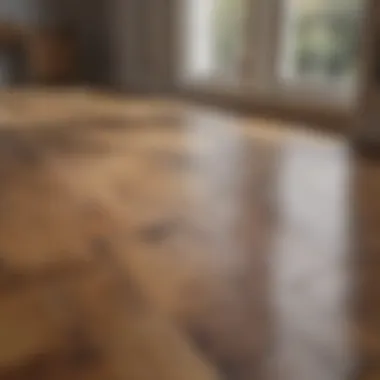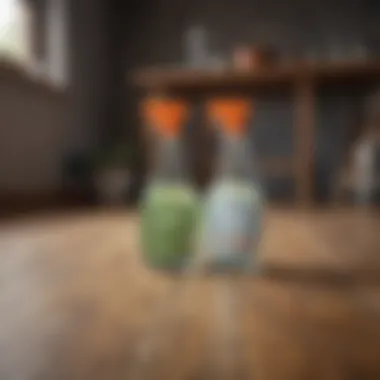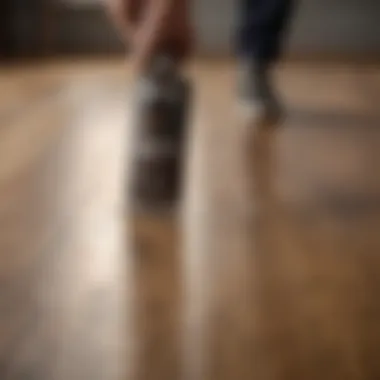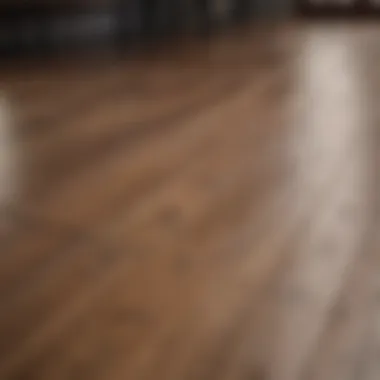Effective Strategies for Reviving Dull Wood Floors


Intro
Dull wood floors can detract from the overall beauty of a home, yet many homeowners overlook the proper cleaning methods to revive these surfaces. Understanding how to clean and maintain wood floors is crucial not only for aesthetic purposes but also for longevity. This guide navigates different strategies tailored for various wood finishes, aiming to provide practical solutions for maintaining beautiful living spaces.
Architectural Inspiration
Overview of Design Styles
When considering the aesthetics of wood floors within architectural design styles, it's essential to recognize how different finishes suit various themes. For instance, modern minimalist designs often favor lighter wood tones that reflect natural light, enhancing the open feel of the space. On the other hand, rustic styles typically embrace deeper finishes that highlight the grain and texture of the wood, contributing to the overall warmth of a room.
Innovative Materials and Techniques
Today, there are several innovative materials and techniques available for cleaning dull wood floors. Eco-friendly cleaning products have gained popularity among homeowners who are environmentally conscious. Using solutions such as vinegar and water or commercially available products specifically designed for wood can provide effective results without damaging the finish.
Among the notable techniques is the application of a microfiber mop, which captures dust and grime effectively without scratching the surface. Furthermore, incorporating a periodic deep-cleaning regimen, which might include steam cleaning or utilizing a soft brush attachment on a vacuum, can significantly enhance the floor's appearance.
"Regular maintenance is key to prolonging the life of your wood flooring and restoring its original luster."
Interior Design Trends
Color Schemes and Their Psychological Effects
The interplay between color schemes and wood flooring is a lesser-explored aspect of design. Light-colored wood can create an airy and open atmosphere, whereas dark wood often adds a touch of elegance and coziness. Understanding this psychological effect can aid homeowners in making informed choices about their cleaning strategies and overall decor.
Space Optimization Tips
Incorporating wood floors into your space requires an understanding of design principles that optimize appearance and functionality. Combining wood flooring with rugs not only protects against wear but also introduces texture and color variety. Moreover, strategically placing furniture can enhance the flow of the room, allowing the beauty of the wood to shine through while maintaining cleanliness and order.
In summation, cleaning dull wood floors involves more than mere surface maintenance. It requires an appreciation for design trends and an understanding of the materials used in creation. A well-maintained wood floor can transform a living space, making it feel fresh and inviting.
Understanding Dull Wood Floors
Understanding dull wood floors is crucial for maintaining the beauty and integrity of your wood surfaces. Dullness can arise from multiple factors, including daily wear and tear, improper cleaning, or using unsuitable products. Knowing these elements enhances your ability to properly care for your floors and prevent long-term damage. This section will provide insight on the causes of dullness and the characteristics of various wood finishes, leading to effective cleaning strategies.
Causes of Dullness in Wood Floors
Dullness in wood floors typically stems from several factors. The most common cause is the accumulation of dirt and grime. Dust and soil can settle on the surface of the wood, creating a foggy appearance. Also, frequent foot traffic wears down the protective finish, gradually diminishing the floor's sheen. Another factor is the use of incorrect cleaning products. Many household cleaners contain harsh chemicals that can strip the finish, making floors appear lackluster over time. Finally, moisture damage, such as spills or high humidity, can penetrate the wood, leading to discoloration and dullness. Recognizing these causes helps in selecting appropriate cleaning methods and maintaining the wood's natural beauty.
Types of Wood Finishes and Their Characteristics
Wood finishes vary greatly, each with unique properties that affect their appearance and durability. Understanding these types can help you choose the right cleaning approach.
- Polyurethane Finish: This type is resistant to scratches and is easy to clean. However, it can appear dull if not maintained properly.
- Oil-Based Finish: Producing a warm glow, this finish deepens over time but requires periodic reapplication to maintain its luster.
- Lacquer Finish: Offering a high gloss, lacquer dries quickly and is resistant to moisture but can be challenging to repair if damaged.
- Shellac Finish: This natural finish provides a soft, warm tone but is less durable and more prone to scratches.
- Wax Finish: Though it provides a beautiful sheen, it requires regular upkeep and can dull more quickly under heavy traffic.
Choosing the right cleaning method according to the wood finish will ensure the longevity and aesthetic value of your floors.
In summary, understanding the causes of dullness and the characteristics of different wood finishes equips homeowners to make informed decisions regarding maintenance and cleaning methods. A proactive approach to care can significantly enhance the appearance of wood floors, ensuring they remain a stunning element of your home.
Preparation for Cleaning
Preparation for cleaning dull wood floors serves as a critical stepping stone in restoring their original appeal. Before diving into various cleaning methods, evaluating the current state of the floors and gathering the right tools are essential steps. A thorough preparation phase can save time and effort during the cleaning process and enhance the effectiveness of chosen techniques. This section outlines key aspects and reasons that make preparation essential in achieving optimal results.
Assessing the Condition of the Floors
Assessing the condition of the floors is a fundamental task that guides the cleaning approach. Each wood floor has unique characteristics influenced by the type of finish, age, and wear. Examining the surface carefully helps identify dull spots, scratches, or more serious damage.
Key indicators include changes in sheen, the presence of stains or discoloration, and the overall texture. Taking note of these details allows for a targeted cleaning strategy. Proper assessment enables homeowners to determine whether simple cleaning will suffice or if restorative techniques may be necessary.


Gathering Necessary Cleaning Supplies
Having the right cleaning supplies on hand is vital in ensuring an efficient cleaning process. Below are essential tools and their significance:
Vacuum Cleaner
A vacuum cleaner is a crucial tool for cleaning wood floors. It removes dirt and debris effectively without scratching the surface, making it a preferred choice for many homeowners. A vacuum designed for hard floors, such as the Shark Navigator, often features a bare floor setting that minimizes the risk of damage.
Unique characteristics include multiple attachments for various cleaning needs and the ability to capture fine dust particles. Despite its advantages, one drawback is that using the wrong vacuum head may result in scratches. Ensuring the vacuum is appropriate for wood floors is essential.
Mop
Choosing the proper mop is critical for cleaning wood floors effectively. Microfiber mops are particularly beneficial; they capture dust and dirt without excessive moisture. Their versatility allows for dry dusting as well as damp cleaning.
A key feature is their washable material, reducing waste and providing cost savings over time. However, mops that are too wet may damage wood finishes. It is important to wring out excess water before using them on floors.
Cleaners
Choosing the right cleaners is crucial to avoid harming the wood. Wood floor cleaners, such as Bona Hardwood Floor Cleaner, are formulated specifically for this purpose, ensuring effectiveness without damaging finishes.
An essential aspect is the pH balance, as neutral or specific cleaners will prevent deterioration. However, some commercial cleaners may contain harsh chemicals. Homeowners should carefully read labels to select gentle options that are effective.
Rags
Rags play a significant role in the cleaning process. They are essential for drying surfaces after mopping or applying cleaners. Microfiber cloths are a popular choice, given their ability to trap dust and absorb moisture effectively.
The key characteristic of rags is their reusable nature, contributing to less waste. However, using dirty rags can lead to additional marks or smudges on the floor. Therefore, it is critical to use fresh rags during cleaning.
Buckets
Buckets are often overlooked but are valuable tools in the cleaning process. They serve to hold water and cleaning solutions, making it easier to manage the mopping tasks. A bucket with a wringer is particularly useful as it removes excess moisture from mops, reducing the risk of water damage.
The unique feature here is the convenience they bring in combining cleaning solutions in one accessible place. However, their size and weight can become cumbersome depending on how much liquid is carried.
Basic Cleaning Techniques
The section on Basic Cleaning Techniques is vital in restoring the shine to dull wood floors. Regular cleaning not only enhances the aesthetic of the flooring but also prolongs its lifespan. Dust and debris can accumulate, causing scratches and dullness. Therefore, adopting effective cleaning strategies is important. This section highlights methods that are easy and can easily be incorporated into your routine.
Dusting and Sweeping
Dusting and sweeping should be the first steps in the cleaning process. Regular dusting prevents dirt from settling into the wood grain, which can lead to scratches over time. Use a soft-bristle broom or a microfiber dust mop to capture dust effectively. This technique is quick and straightforward, yet essential for maintaining the wood's appearance.
Here is how to perform this task effectively:
- Choose the Right Tools: Select a broom or mop designed for wood floors. Opt for a soft-bristled broom or a microfiber mop.
- Frequency: Dust at least once a week, or more often in high-traffic areas to keep dirt at bay.
- Technique: Always sweep in the direction of the wood grain. This not only prevents damaging the surface but also helps to lift dust away without scattering it.
"Dusting is the first line of defense against dull wood floors. A regular schedule can dramatically change the appearance and longevity of your flooring."
Mopping with Water
Mopping with water is an excellent follow-up after dusting. It helps eliminate remaining dirt and restores some moisture to the wood. Care must be taken, however, as excess water can damage wood floors. Here’s how to mop effectively:
- Use a Damp Mop: It is essential to ensure the mop is damp, not soaking wet. This minimizes the risk of water damage.
- Warm Water: Use warm water where possible as it can help lift grime better than cold water.
- Technique: Mop in a straight line, following the wood's grain. Periodically rinse the mop in fresh water to avoid spreading dirt around.
- Drying: After mopping, allow the floor to dry thoroughly to prevent moisture buildup.
Using Wood Floor Cleaners
For deeper cleaning, using specialized wood floor cleaners is effective. These products are formulated to remove dirt without harming the finish of the wood floor. It is important to choose a cleaner that suits your specific type of finish. Here’s how to make the most of wood floor cleaners:


- Read Labels: Always check that the cleaner is compatible with your wood finish. Some formulations are made for specific finishes only.
- Apply Sparingly: A little goes a long way. Use a minimal amount on a microfiber mop to avoid buildup.
- Routine Cleaning: Consider incorporating cleaner solutions into your bi-weekly or monthly routine, depending on foot traffic and the degree of dullness.
By integrating these basic cleaning techniques into regular maintenance, you can uphold the natural beauty and integrity of your wood floors.
Advanced Cleaning Solutions
Advanced cleaning solutions play a significant role in restoring the shine and appeal of dull wood floors. These methods go beyond basic cleaning techniques to tackle ingrained dirt and imperfections. They are often more effective in rejuvenating the wood's natural grain and enhancing its overall appearance. Moreover, advanced techniques can prolong the lifespan of the floor, making them a worthwhile investment for homeowners.
Homemade Cleaning Solutions
Homemade cleaning solutions provide an eco-friendly alternative to commercial products. They often utilize simple household ingredients that are readily available, making them convenient and cost-effective options.
Vinegar and Water Mix
The vinegar and water mix is a timeless method for cleaning wood floors. This solution combines water with vinegar, creating a gentle yet effective cleaner. One of its key characteristics is that it is acidic enough to break down grime while remaining safe for most wooden finishes. This makes it a popular choice for those looking to avoid harsh chemicals.
Unique to this solution is its ability to remove light stains and odors without leaving residues. However, it is important to use it sparingly on floors with specific finishes like wax or oil, as frequent use can cause damage.
Soap and Water
A simple soap and water solution is another effective method. This combination leverages the cleaning power of soap to lift dirt and grime from the floor's surface. The key characteristic of this method is that it is gentle; therefore, it is suitable for regular maintenance. Many find it to be a beneficial choice for wooden surfaces that require a softer touch.
The unique feature of the soap and water mix is its versatility. It can be used on a variety of wood finishes without much risk. However, one should always ensure to rinse well, as soap residue can lead to dulling over time.
Commercial Products for Wood Floors
Commercial products offer a broader range of specialized solutions, designed to address particular issues with wooden floors. They can be powerful allies in maintaining and restoring wood without the effort needed for traditional methods.
How to Choose a Product
Choosing the right product is crucial to avoid damaging wooden floors. When selecting a commercial product, consider the type of finish on your wood—a product suitable for urethane finishes may not work well on oiled floors. The primary characteristic of effective products is their formulation; they should be pH balanced and free from harmful solvents. This specificity makes informed selection essential.
Each product also has its unique feature, whether it is a concentrated formula for deep cleaning or a spray for quick touch-ups. It's wise to read reviews and check for certifications to ensure effectiveness and safety.
Top Rated Products
Top-rated products are often recommended by professionals and have been tested for effectiveness. Their contribution is mostly in improved ease of use and guaranteed results. A critical characteristic of these products is their reliability; they deliver consistent outcomes, saving time and effort.
Many top-rated cleaners have been designed to address issues specific to wood graining and finish types. While they are typically more expensive than homemade options, their quick action and efficiency can justify the cost. Be mindful, however, of potential over-reliance on such products, as it might lead to neglecting more fundamental maintenance routines.
Restorative Techniques
Restorative techniques are essential for reviving the appearance of dull wood floors. These methods not only enhance the visual appeal but also extend the life of the flooring. When floors lose their luster, it often signals that routine cleaning is not enough. Instead, more intensive approaches like polishing, waxing, and buffing may be required. Understanding these techniques allows homeowners to make informed decisions about their maintenance plans.
Polishing Wood Floors
Polishing wooden floors typically involves applying a specialized product that helps bring back the shine and luster. The process can fill in minor scratches, improve the protective layer and enhance the wood's natural color.
When choosing a polish, it's important to consider the type of wood finish already applied to the floor. Some polishes work better on certain finishes than others. For example, urethane finishes may require a specific polish as opposed to oil-based finishes.
Before applying any polish, ensure the floor is clean and dry. This prevents dirt or debris from getting trapped under the product, which could lead to further dullness. After applying polish, allow it to dry thoroughly for the best results. This is key to achieving a long-lasting shine.
Using Floor Wax
Waxing wood floors can provide a durable protective coating that enhances the floor's finish. Wax creates a barrier between the wood and foot traffic, moisture, and dirt. This method has been a favorite for many home designers due to its ability to give floors an elegant shine.
To use wax effectively, floors need to be properly prepared. Begin by cleaning the surface thoroughly using a wood-safe cleaner. Once cleaned and dried, apply a thin layer of wax using a soft cloth or applicator. This ensures an even distribution. After waxing, buff the floor to achieve the desired shine. Some people find that a combination of different types of wax can lead to a more appealing finish.


Buffing for Shine
Buffing is a vital step that can elevate the overall appearance of wood floors. It involves using a buffing machine or a buffer applicator to polish the surface and enhance its shine. This technique can yield immediate results, making floors look brand new.
Before the buffing process, floors should be cleared of any furniture and cleaned thoroughly. Once the floor is clean, a buffing pad chosen for wood surfaces can be used. Starting on one side and working towards the other is recommended to avoid missing spots. It's important to apply consistent pressure while buffing to achieve an even shine.
"Regular buffing not only improves the shine but also keeps the protective finish intact, reducing the need for more aggressive restoration methods in the future."
In summary, each of these restorative techniques—polishing, waxing, and buffing—offers distinct benefits that contribute significantly to maintaining beautiful wood floors. Adopting these methods as part of a regular maintenance routine can ensure that the integrity and aesthetics of wood flooring remain intact for years to come.
Preventative Maintenance
Preventative maintenance is essential for preserving the beauty and longevity of wood floors. It involves proactive steps to safeguard against wear and damage before they occur. This maintenance approach can significantly reduce the likelihood of dullness and protect the floor's finish. Regular upkeep not only enhances the aesthetic appeal of the floors but also saves time and money in the long run. Focusing on prevention means fewer intensive cleaning or restoration sessions are needed in the future.
Establishing a Cleaning Schedule
Creating a cleaning schedule ensures that wood floors are regularly attended to. This structure helps in avoiding dirt buildup and eliminates the need for harsh cleaning products. A simple routine could involve sweeping or dusting multiple times a week, with deeper cleaning sessions scheduled once a month. Adjusting the frequency based on traffic levels or season can be helpful. For instance, during the winter, more frequent cleanings may be necessary due to the accumulation of salt and sand.
Protective Measures for Floors
Area Rugs
Area rugs serve as a vital protective measure for wood floors. By placing them in high-traffic areas, you can minimize the wear on the floor surface. The key characteristic of area rugs is that they can absorb impact and shield wood from scratches. They also add an element of style, enhancing the overall room decor. The unique feature of area rugs is their ability to be easily cleaned or replaced if necessary. While they provide significant advantages, it is important to choose rugs that are not too abrasive on the wood surface, which can lead to further issues.
Furniture Pads
Furniture pads are another crucial protective measure for wood floors. These are often made from soft materials and are applied to the legs of furniture. The key characteristic of furniture pads is their ability to prevent slipping and reduce the impact of heavy furniture on the floor. This helps in preserving the finish and preventing scratches. Their unique feature lies in their affordability and ease of installation. While they can greatly enhance protection, it is important to regularly check and replace them as they may wear down over time.
Environmental Considerations
Understanding how cleaning products impact the environment is essential when it comes to maintaining dull wood floors. With growing awareness of environmental issues, many homeowners seek methods that not only clean effectively but also minimize harm to the planet. The choices made in cleaning methods can contribute to sustainability and health.
One significant aspect is the use of eco-friendly cleaning products. These products often rely on natural ingredients that are less toxic than their chemical counterparts. By selecting greener options, such as biodegradable cleaners, individuals can significantly reduce their environmental footprint. They often work just as well, or even better, than traditional cleaners without releasing harmful substances into the air or water systems.
Additionally, avoiding harmful chemicals plays a crucial role in protecting health and well-being. Many conventional floor cleaners contain volatile organic compounds (VOCs), which can lead to indoor air pollution. This pollution may have adverse effects, particularly for those with sensitivities or allergies. Therefore, choosing non-toxic options promotes a healthier living space.
By integrating these practices into the cleaning routine, homeowners not only rejuvenate their wood floors but also contribute positively to the environment. The shift to eco-friendly products aligns cleaning practices with a broader commitment to sustainability, making it paramount in today’s ecological landscape.
"The choices we make can echo in our environment for years to come."
Eco-Friendly Cleaning Products
When selecting cleaning products for wood floors, consider those labeled as eco-friendly. These cleaners are typically formulated with plant-based ingredients and avoid harmful chemicals. Some common eco-friendly products include:
- Vinegar: An effective natural cleaner that breaks down dirt and grime.
- Baking Soda: A gentle abrasive that can help lift tough stains without scratching the wood.
- Castile Soap: A versatile, biodegradable soap that cleans various surfaces, including wood floors.
Choosing these options supports sustainability and minimizes the potential for adverse health effects from traditional cleaning agents.
Avoiding Harmful Chemicals
It is crucial to steer clear of dangerous chemicals when cleaning wood floors. Products that contain acid, ammonia, or bleach can damage the floor's finish and worsen dullness. Instead, one should:
- Read Labels: Always examine product labels for harmful ingredients such as VOCs.
- Research Alternatives: Seek out articles or forums discussing effective alternatives to harsh chemicals. Websites like reddit.com can provide valuable insight into recommended products.
- Test Before Use: If uncertain, always do a small patch test on an inconspicuous area of the floor to ensure the product is safe.
End
Cleaning dull wood floors is not just about aesthetics; it’s a matter of preserving the integrity and longevity of the wooden surfaces. This article emphasizes several key elements in effective cleaning practices. First, understanding the causes of dullness allows homeowners to target specific problems, ensuring more effective interventions. Techniques ranging from basic to advanced cleaning solutions provide a spectrum of options suitable for various types of finishes and conditions. Emphasizing eco-friendly products resonates with an increasingly environmentally conscious audience, making sustainable choices an integral part of maintenance strategy.
Summary of Effective Cleaning Practices
To maintain the vibrancy of wood floors, various effective methods are advocated. Dusting and sweeping should be regular practices to prevent dirt buildup. Mopping with water, alongside using specialized wood floor cleaners, removes more stubborn residues effectively. For those looking to rejuvenate their floors further, polished finishes and wax applications can significantly enhance appearance. Commercial products, when chosen wisely, can also complement homemade solutions, creating a balanced cleaning regimen.
Encouragement for Ongoing Maintenance
Ongoing maintenance is crucial. Establishing a cleaning schedule tailored to the specific usage and surroundings of the floors can lead to noticeable improvements. Regular attention can avert further dullness and degradation. Protective measures, such as using area rugs and furniture pads, contribute significantly to minimizing wear and preserving the finish. By integrating these preventative steps into daily life, homeowners not only maintain aesthetics but also extend the lifespan of their beautiful wood floors.







